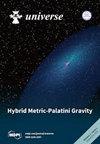非微量耦合电磁场及其对原始黑洞的可观测影响
IF 2.5
4区 物理与天体物理
Q2 ASTRONOMY & ASTROPHYSICS
引用次数: 0
摘要
广义相对论(GR)的假设已得到高精度验证,但我们对引力如何与物质场相互作用的理解仍不完整。为了解决强引力机制下的这些相互作用,人们在经典和量子领域提出了对 GR 的各种修正。其中一种方法是非最小耦合(NMC),即时空曲率(标量和张量)与物质场相互作用,导致物质场不遵循大地线。为了探究 NMC 的天体物理意义,我们在这项工作中研究了存在黑洞的非最小耦合电磁(EM)场。具体来说,我们发现原始黑洞(PBHs)为约束 NMC 参数提供了一种可能的工具。原始黑洞是一类不符合无毛定理的有趣的宇宙学黑洞。我们将 PBH 建模为苏尔塔纳-戴尔黑洞,并与施瓦兹柴尔德黑洞进行比较。我们研究了施瓦兹柴尔德黑洞和苏尔塔纳-戴尔黑洞的光子球半径、临界撞击参数和非最小耦合光子的总偏转角等观测指标。两种黑洞时空对 NMC 参数都有类似的限制。对于质量为M=10-5M⊙的PBH,光子球不会形成一种模式。因此,形成光子球的光子将高度偏振,可能导致可观测的影响。本文章由计算机程序翻译,如有差异,请以英文原文为准。
Non-Minimally Coupled Electromagnetic Fields and Observable Implications for Primordial Black Holes
General relativity (GR) postulates have been verified with high precision, yet our understanding of how gravity interacts with matter fields remains incomplete. Various modifications to GR have been proposed in both classical and quantum realms to address these interactions within the strong gravity regime. One such approach is non-minimal coupling (NMC), where the space-time curvature (scalar and tensor) interacts with matter fields, resulting in matter fields not following the geodesics. To probe the astrophysical implications of NMC, in this work, we investigate non-minimally coupled electromagnetic (EM) fields in the presence of black holes. Specifically, we show that primordial black holes (PBHs) provide a possible tool to constrain the NMC parameter. PBHs represent an intriguing cosmological black hole class that does not conform to the no-hair theorem. We model the PBH as a Sultana–Dyer black hole and compare it with Schwarzschild. We examine observables such as the radius of the photon sphere, critical impact parameter, and total deflection angles for non-minimally coupled photons for Schwarzschild and Sultana–Dyer black holes. Both the black hole space-times lead to similar constraints on the NMC parameter. For a PBH of mass M=10−5M⊙, the photon sphere will not be formed for one mode. Hence, the photons forming the photon sphere will be highly polarized, potentially leading to observable implications.
求助全文
通过发布文献求助,成功后即可免费获取论文全文。
去求助
来源期刊

Universe
Physics and Astronomy-General Physics and Astronomy
CiteScore
4.30
自引率
17.20%
发文量
562
审稿时长
24.38 days
期刊介绍:
Universe (ISSN 2218-1997) is an international peer-reviewed open access journal focused on fundamental principles in physics. It publishes reviews, research papers, communications, conference reports and short notes. Our aim is to encourage scientists to publish their research results in as much detail as possible. There is no restriction on the length of the papers.
 求助内容:
求助内容: 应助结果提醒方式:
应助结果提醒方式:


